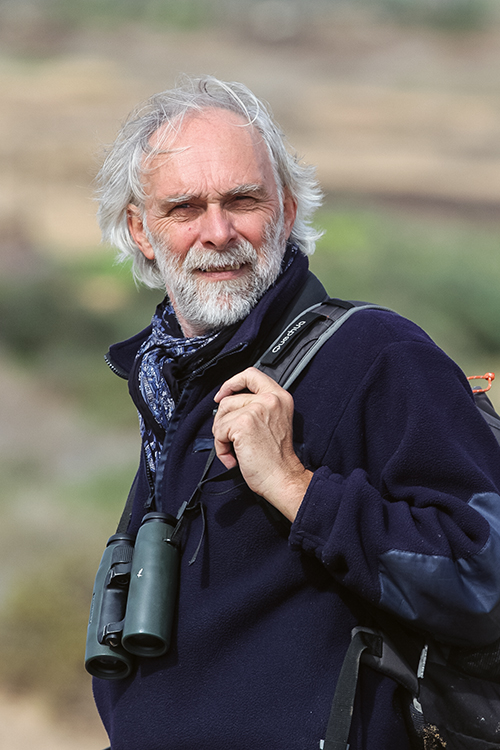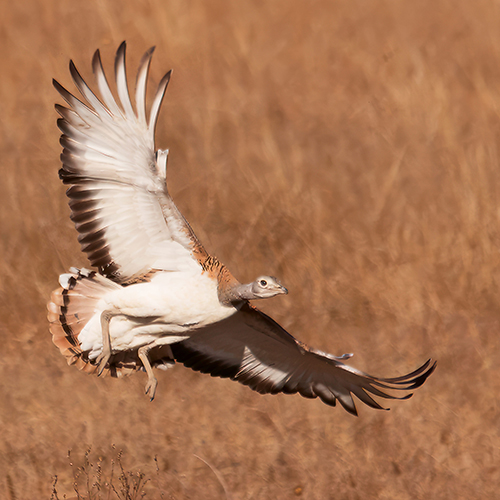Nature and Wildlife of the Algarve – by Crossbill Guides
Naturalists, birdwatchers, ramblers, photographers and all other nature lovers, a warm welcome on this page about the nature and wildlife of the Algarve. This website accompanies the Crossbill nature travel guide to Southern Portugal – From Lisbon to the Algarve. It is meant as an online Crossbill Guide ‘light’, offering you some general insights and images to warm you up for your stay, plus some practical information, sites and a free route from the Crossbill Guide. Enjoy!
Imagine you are a Black Kite. You are returning to Europe in spring and flying over southern Portugal to your nearby breeding grounds. You hit land on the southern coast of Portugal, the Algarve. Below are thousands of shorebirds feeding in the tidal marshes readying themselves to push further north to the high Arctic. You press on, passing above the resorts and golf courses (by which most people know the region). Then you reach a gently rolling land with vast oak pastures, large areas of steppes and clean rivers with birds and wildflowers everywhere. You’re back home in the splendid quietude of the interior of southern Portugal, your own paradise.
Landscape of the Algarve
The Algarve – a triplet of landscapes
The Algarve has three different types of landscapes: the littoral, the barrocal and the interior. This triplet coincides neatly with the geological background. Even the wildlife is fairly well grouped in these three.
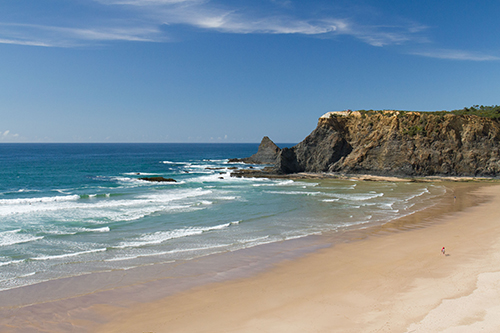
The coast or littoral is the geologically youngest landscape, with large coastal marshes and estuaries. There are flat coasts with broad beaches but also headlands and cliffs.
The barrocal refers to a band of limestone that lies a few kilometres further inland. The barrocal is hilly, with Mediterranean scrubland, olive and carob groves and open woodlands. It sports a beautiful flora.

The interior is furthest from the coast and extends all the way north into Alentejo and beyond, into Spain. The interior has a gently rolling topography, but the ground is generally stony or even rocky, and consists of geologically very old bedrock. This region is covered by swathes of holm and cork oak savannahs and steppe grasslands, which harbour a very rich birdlife.

Coastal marshes
Numerous small rivers flow down from the hills, each feeding a small estuary of marshes. All these estuaries together form a string of wetlands all along the Algarve coast. Around Faro, where the land is more level, lies the Ría Formosa – a mixture of saline and freshwater marshes with a tremendously rich birdlife, with flamingos, various species of wildfowl and plenty of waders.
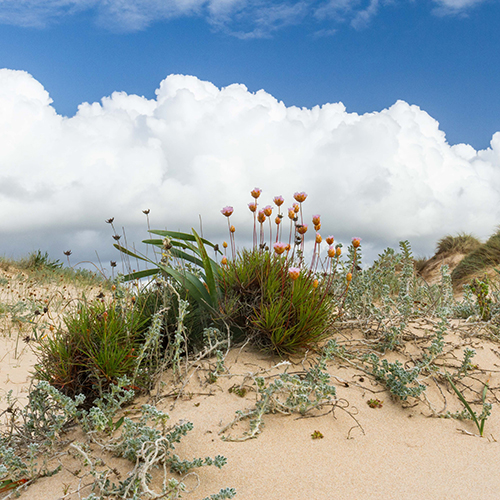
Dunes and coastal woodlands
Both on the headlands and in the lowlands, there is a mix of dunes, open woodlands of umbrella pines and low machia (maquis). All of these have a brilliant and special flora and fauna. Particularly special are scrublands on the southwestern headlands, the area known as Costa Vicentina. Here the Atlantic ocean softens the Mediterranean climate and makes for exceptionally mild winters – a microclimate in which a rare flora evolved.
Sadly, the coastal zone of the southern and eastern Algarve is threatened by tourism and housing developments, and particularly by golf courses, that take up a lot of space and use a devastating amount of water.

Fields, olive groves and scrublands of the Barrocal
Inland, the limestone soils are covered by a lovely mix of habitats, with scrubland, fields and olive groves. There are some rocky parts but overall, the landscape is gentle and, particularly in early spring, verdant and green. Being porous, water sinks away easily in limestone. Cracks in the bedrock channel the water underground where it finds its way to a spring. There is only a limited number of these springs, but because they are fed by an elaborate underground system, the rivers the flow from there retain a fairly steady flow of water year-round. The river valleys are true oases and boast a wealth of life, including many birds.
The scrublands, field edges and roadsides in the barrocal form the best spots in the Algarve for wild orchids and butterflies.
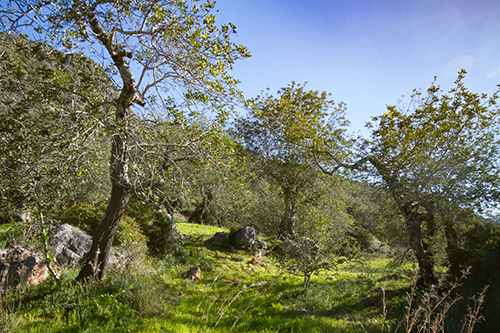
Montados
Further inland, the interior is covered by vast swathes of Montados – savannah-like pasture-woodlands dominated by Holm and Cork Oaks. These grassy woodlands are something special for the south-eastern part of the Iberian Peninsula (extending into Spain where they are known as dehesa).

They have an unsurpassed birdlife, with exceptionally high numbers of Hoopoes, Bee-eaters, Thekla’s Larks, Woodchat and Iberian Grey Shrikes, Azure-winged Magpies and many more. In contrast, the flora is not so diverse, but consists of several typical species that are excessively flowery, particularly in spring, between early March and late May.
Steppes
In several areas the oaks are lacking and the grasslands form extensive, open pasturelands – a form of steppe, but one that is quite different from the natural steppes in eastern Europe.
In terms of reptiles, plants and insects, the steppes are quite similar to the montados, but the birdlife is quite different, with rare and sought-after species like Great and Little Bustard and Great Spotted Cuckoo still occurring in large numbers (and many other species). The steppes are therefore mostly a birdwatching destination, although the stark landscapes have a great attraction as well, in particular for photographers.
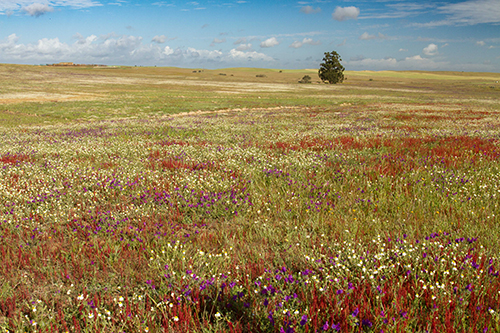
The naturalist top 8
Eight highlights of your visit to the Algarve.
Even though they are a tourist hotspot and not the richest place in terms of wildlife, the beautiful creamy-golden sandstone cliffs are an unforgettable hallmark of the Algarve. It can be explored on foot via coastal trails, or on a boat trip.
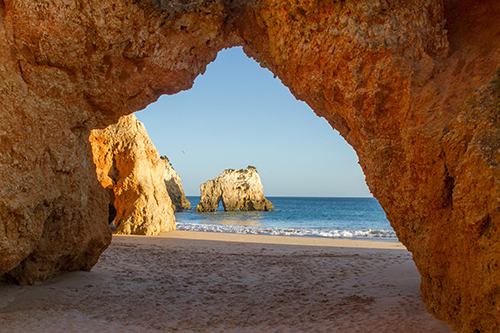
Nearly flat and rocky, the Sagres plateau plateau stretches out to Cabo Sao Vicente, where it drops down to the ocean a series of dramatic cliffs. The plateau has a unique microclimate, boasting a superb flora. In autumn this is a spot to watch bird migration.
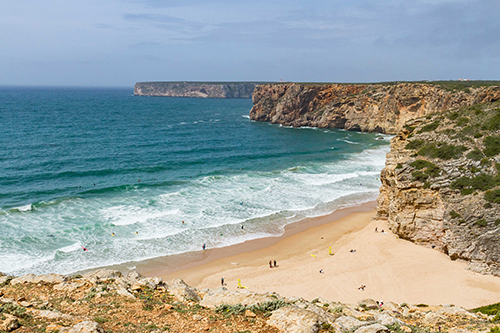
There are several options to watch seabirds, dolphins and whales. From headlands like Cabo Sao Vicente and, further north, Cabo Sardao (with, uniquely, a ‘seabird colony’ of Shags and White Storks!). Even better is seabird or whale watching boat trip from Sagres.

The village of Monchique sits in the saddle between the two highest peaks of the Algarve, which provide superb views over the surrounding lowland. Thick cork oak woods and Mediterranean-style heathlands surround the village.

Deserted and wild, the Costa Vicentina stretches from Europe’s southwesternmost point in northern direction. Spectacular cliffs and headlands alternate with small and unspoilt estuaries, and all are a naturalists delight, with plenty of hiking opportunities.

Several river estuaries merged together form the large braided delta around the town of Faro, known as the Ria Formosa. A series of barrier islands shield this large tidal marsh from the sea. It is a superb area for birds.

The splendidly picturesque countryside of the barrocal (particularly in spring) consists of steep limestone hills, locally with cliffs, with groves of olive and locust tree. Peaceful and quiet, it is also the area to search for orchids.

On the border with Spain, the Guadiana river forms a delta near Castro Marim. This area is rich in birds, several of which are found more commonly in Spain, but less so in Portugal (e.g. Audouin’s and Slender-billed Gulls). It is also among the best places to see Common Chameleon.
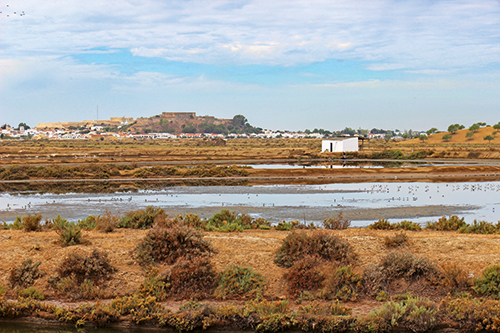
Birds, Orchids, Salamanders – The Flora and Fauna of the Algarve
Flora
The true wildflower hotspots are found along the west coast and the limestone interior. The cliffs and headlands of Sao Vicente are a true delight, with large numbers of species that are either restricted to this southwestern cape, or only occur here and the further north along the coastline. The low macchia, in which the very shiny-leaved Saint Vicent Cistus is dominant, there are various endemic species of toadflax, thrift, allium and more. Another typical wildflower here is the rare orchid Two-leaved Gennaria (Gennaria diphylla).

Ophrys tenthredinifera
Even more special (and harder to reach) is the cliff flora, which has species that are are only found on these southwestern Portuguese coastal cliffs, like the Shrubby Violet Viola arborescens and the catchfly Silene rothmaleri.
The limestone barrocal is the place to look for orchids, with large numbers Naked-man, Pink Butterfly, Mirror, Yellow Bee and Bumblebee Orchids, and that’s just the tip of the iceberg. Another typical and conspicuous wildflower here is the Portuguese Squill.

Cistanche phelypaea
Birds
The Algarve is a popular destination for birdwatchers, with the coastal lagoons and the interior montado and steppe landscapes being the prime spots. The best spots of the latter are mostly in the Alentejo.
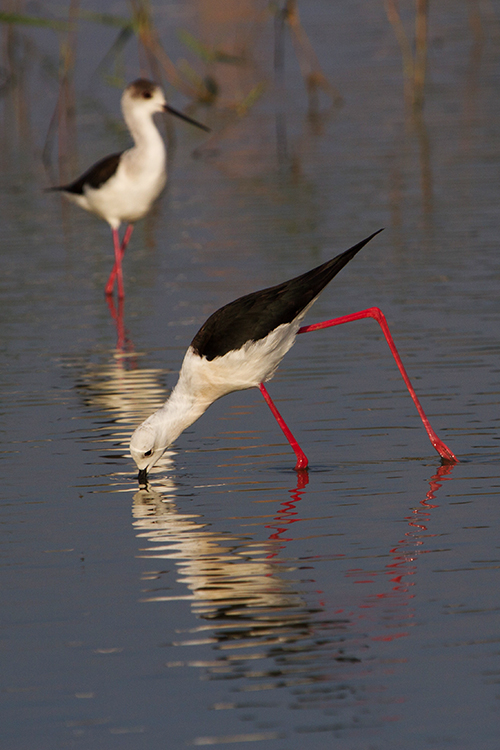
Black-winged Stilt
The coastal lagoons play host to thousands of waders and flamingos, whilst the brackish and freshwater lagoons are home to Purple Swamphens, Red-crested Pochards, herons and ibises. Equally attractive are the scrublands, fields and open woodlands, where Azure-winged Magpies, Bee-eaters, Iberian Grey Shrikes and Hoopoes are very numerous.
In the interior, steppe birds and raptors are the true delights. Both bustards, Stone Curlews, Great Spotted Cuckoos (numerous) and Black-bellied Sandgrouse can be found here, as well as Montagu’s Harrier, Griffon Vulture, Golden and Spanish Imperial Eagle.
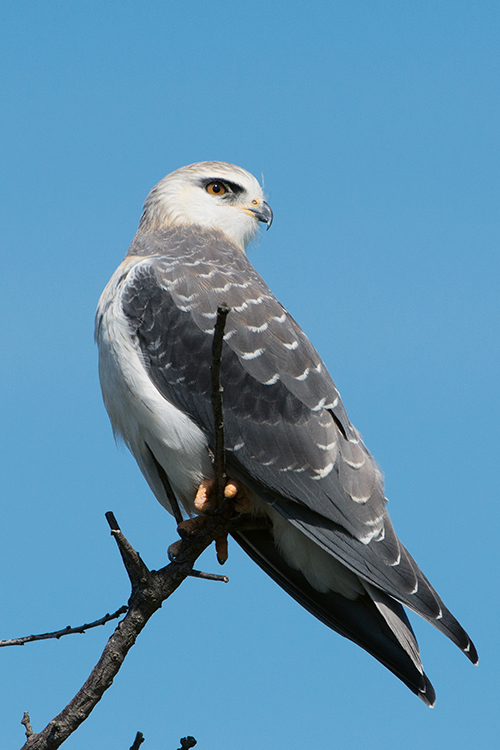
Black-winged Kite
Reptiles
Being a warm country with a Mediterranean climate, it should not come as a surprise that there are many reptiles in the Algarve. Of the eight species of snake, the Montpellier Snake is the largest, living in dry, lightly wooded terrain. Lizards are plentiful and include the large, up to 80 centimetres long Ocellated Lizard. A reptilian highlight is the Chameleon, which occurs in the eastern part of the coastal Algarve, roughly up to Faro.

Large Psammodromus
Butterflies and dragonflies
As the Algarve is rather low and uniform, it is not terribly rich in butterfly species. However, the region has a number of attractive southwestern European specialities like Lorquin’s and False Baton Blue, Provence Hairstreak and Spanish Fritillary. A common spring butterfly is the Spanish Festoon. The splendid Two-tailed Pasha is particularly numerous in Monchique and de Costa Vicentina, whereas the equally smashing Monarch holds small populations along the south coast, mostly near towns and villages.
The Algarve’s rivers are surprisingly attractive for dragonflies. Although information on dragonfly occurrences are still sketchy, there are sites known for rare south(western) species like Green Hooktail, Dark Spreadwing, Long and Epaulet Skimmers and Western Spectre. Copper Demoiselles and Violet Dropwings are numerous.
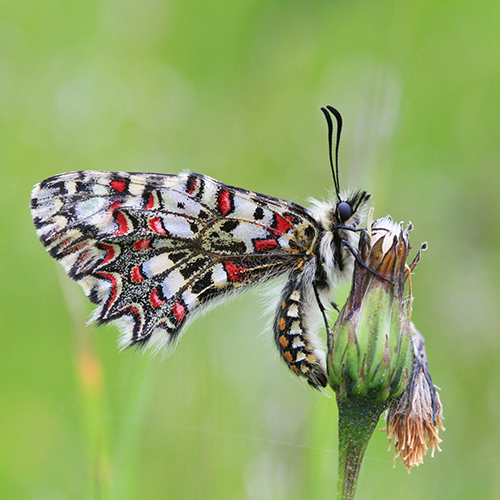
Spanish Festoon
Top 10 species
Ten superb plant and animal species of the Algarve.
This beautiful, noisy bird lives in social groups and is common in the Algarve, but its world distribution is limited to the southwestern half (approximately) of the Iberian Peninsula.

This small green orchid is the only species in the Gennaria genus and is only commonly found in the southwestern part of Portugal, Madeira and the Canaries (plus a handful of sites in Spain, France and Italy). It is quite common along the Costa Vicentina, but flowers very early, from January to March.
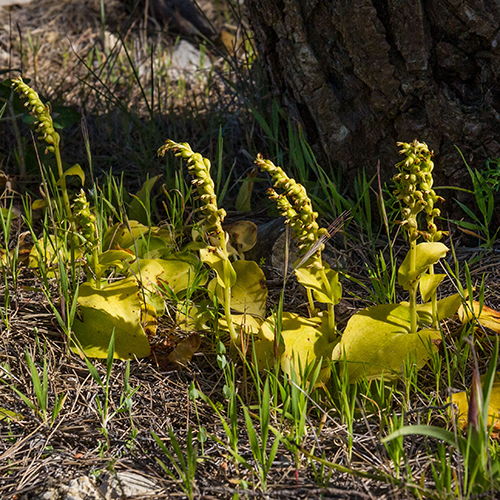
Mirror Orchids are spectacular and quite numerous in the region. The Lusitanian Mirror Orchid is closely related and restricted to southern Portugal and adjacent Andalucia, and even here it is not common.

Another south-west Iberian delight, and one that is quite common in roadsides in the Barrocal. When in flower (March-May) this stout plant cannot be missed.

One of the largest and most beautiful butterflies of Europe, the Two-tailed Pasha only occurs where there are Strawberry trees. In Portugal, this is a common tree, and so is the butterfly, which is seen mostly near the coast, with numbers building up from spring to autumn.

This spectacular creature is the only Chameleon found in Europe. It is native on the southern and eastern Mediterranean coast, but the Iberian populations were probably introduced by the Romans or Arabs. It occurs close to the coast, where it prefers open broom shrubs. Despite it being a bulky animal, it is surprisingly hard to find.
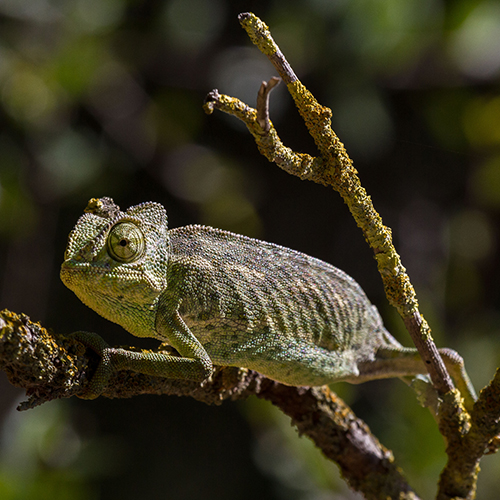
This oversized and intensely purple version of the Moorhen is locally common in bulrush beds in the estuaries of the Algarve.
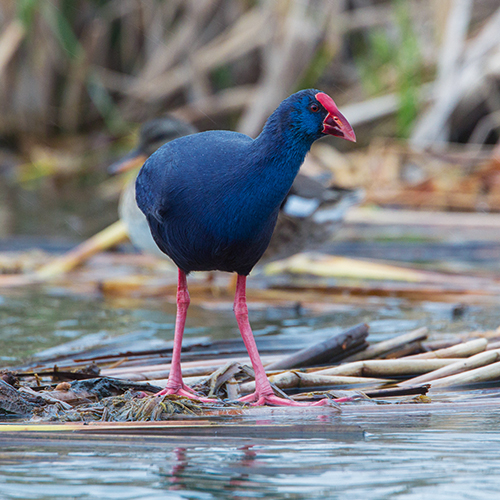
The Egyptian Mongoose is an otter-sized carnivore that is common throughout the region and diurnal. Take your time and sooner or later one will cross your path. Like the Chameleon, the Mongoose was introduced, probably by the Arabs.

The Shrubby Violet is one of the ‘ultra-endemics’ of the Costa Vicentina – its world distribution is limited to a small section of cliffs in the extreme south-west of Portugal.

Routes and practicalities
The car provides the greatest flexibility in visiting places off the beaten track. However, a combination of trains and buses can bring you deep into the countryside, from where walking or cycling will allow one to access many areas.
Sustainable tourism – Do’s & Don’ts
Do
- Buy local products from the agriturismos, farmers and other locals. It is easy, always surprising and it supports traditional land use.
- Support the local ecotourism community by staying in local guest houses, hiring local guides, booking a bird hides, etc.
- Visit nature preserves, natural history museums and talk to the people there and see in what other ways you can support.
- Show that you have come for wildlife and always be friendly to local people; in other words be an ambassador of nature tourism.
Don’t
- Obviously, don’t disturb wildlife. Especially the larger mammals and raptors are easily spooked, so keep a low profile.
- Be careful when driving. Driving slow helps you to avoid collision with wildlife and will also offer good viewing options.
The book
The Crossbill Guides are the most comprehensive nature travel guides available. Each Crossbill Guide covers in depth descriptions on landscape, habitats, geology and all the species groups, and links these to routes where this can be seen.
These routes are typically a mixture of walking and car routes with stops and short walks. Combined, they cover all the sites for birdwatching, butterflies, dragonflies, plants, mammals and reptiles. They are also set out to give you the finest examples of the ecosystems and geological features.
The Crossbill Southern Portugal Guide covers:
- 280 pages
- Landscape history
- Ecosystems
- Geology
- Flora and Fauna
- Where to watch birds
- Finding mammals, reptiles, butterflies, dragonflies and wildflowers
- 23 detailed routes with tips for finding wildlife and 28 site descriptions
The authors
Dirk Hilbers (NL, 1976), set up the Crossbill Guides Foundation and travels Europe to research the guidebooks. This is the 23rd guide he worked on. As a biologist, when not in the field, Dirk Hilbers is a lecturer at the University of Amsterdam.

Kees Woutersen (NL, 1956) has lived in Huesca for 20 years, work- ing as a nature and bird guide throughout Spain. He runs his own travel company and is author of various books on birds and natural history. This is his 5th Crossbill Guide.
